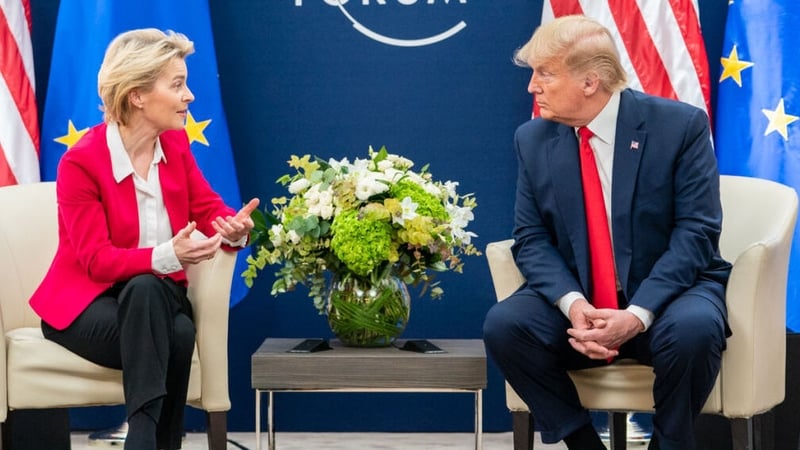US President Donald Trump threatened to impose a 30% tariff on imports from the European Union and Mexico starting on 1 August.
It follows weeks of negotiations with the major US trading partners failed to reach a trade deal.
In an escalation of the trade war that has angered US allies and rattled investors, Mr Trump announced the latest tariffs in separate letters to European Commission President Ursula von der Leyen and Mexican President Claudia Sheinbaum that were posted on his Truth Social media site on Saturday.
The EU and Mexico responded by calling the tariffs unfair and disruptive while pledging to continue to negotiate with the US for a broader trade deal before the deadline.
Watch: US tariffs a ‘significant setback’ – Taoiseach
The EU and Mexico are among the largest US trading partners.
Mr Trump sent similar letters to 23 other trading partners this week, including Canada, Japan and Brazil, setting blanket tariff rates ranging from 20% up to 50%, as well as a 50% tariff on copper.
Mr Trump said the 30% rate was “separate from all sectoral tariffs,” which means 50% levies on steel and aluminium imports and a 25% tariff on auto imports would remain.
The 1 August deadline gives the targeted countries time to negotiate agreements that could lower the threatened tariffs.
The spate of letters shows Mr Trump has returned to the aggressive trade posture that he took in early April when he announced a slew of reciprocal tariffs against trading partners that sent markets tumbling before the White House delayed implementation.
‘Unfair treatment’
But with the stock market recently hitting record highs and the US economy remaining resilient, Mr Trump is showing no signs of slowing down his trade war.
The US president promised to use the 90-day delay in April to strike dozens of new trade deals, but has only secured framework agreements with the UK, China and Vietnam.
The EU has hoped to reach a trade agreement with the US for the 27-country bloc.
Mr Trump’s letter to the EU included a demand that Europe drop its own tariffs, an apparent condition of any future deal.

“The European Union will allow complete, open market access to the United States, with no tariff being charged to us, in an attempt to reduce the large trade deficit,” he wrote.
Ms von der Leyen said the 30% tariffs “would disrupt essential transatlantic supply chains, to the detriment of businesses, consumers and patients on both sides of the Atlantic.”
She also said while the EU will continue to work towards a trade agreement, it “will take all necessary steps to safeguard EU interests, including the adoption of proportionate countermeasures if required.”
Mexico’s economy ministry said Saturday it was informed the US would send a letter during a meeting on Friday with US officials.
“We mentioned at the roundtable that it was unfair treatment and that we did not agree,” the ministry’s statement said.
‘Deeply regrettable’
Taoiseach Micheál Martin said he hopes negotiations will continue in the weeks ahead and said the EU and US should be partners and not rivals.
In a post on X, Mr Martin said the EU and the US enjoy the biggest trade and investment relationship in the world and that “when issues arise between us, they should be resolved by close and respectful dialogue.
Tánaiste and Minister for Foreign Affairs and Trade Simon Harris described the move by Mr Trump as “deeply regrettable”.
“There is no necessity to escalate the situation or to further increase the additional tariffs which have been imposed on the EU.
“The Government strongly supports the efforts by the European Commission to reach a mutually beneficial agreement with the US,” Mr Harris said.
Read More:
EU states told not to expect stable trade relationship with US
Pharmaceutical tariffs could reach 200%, says US President
He added: “The EU is at the negotiating table and will remain there. Now is the time to redouble our efforts and to seek to achieve positive results in the time available.”
The EU had initially hoped to strike a trade agreement but more recently had scaled back its ambitions and shifted toward securing a broader framework deal similar to the one the UK brokered that leaves key details to be negotiated.
The bloc is under conflicting pressures as powerhouse Germany urged a quick deal to safeguard its industry, while other EU members, such as France, have said EU negotiators should not cave into a one-sided deal on US terms.
Jacob Funk Kirkegaard, a senior fellow at the Brussels-based think tank Bruegel, said Mr Trump’s letter raised the risk of retaliatory moves by the EU similar to the flare-up between the US and China that rattled financial markets.

“US and Chinese tariffs went up together and they came back down again. Not all the way down, but still down together,” he said.
Mr Trump’s cascade of tariff orders since returning to the White House has begun generating tens of billions of dollars a month in new revenue for the US government.
US customs duties revenue topped $100 billion in the federal fiscal year through to June, according to US Treasury data yesterday.
The tariffs have also strained diplomatic relationships with some of the closest US partners.
Japanese Prime Minister Shigeru Ishiba said last week that Japan needed to lessen its dependence on the US.
The fight over tariffs has also prompted Canada and some European allies to re-examine their security dependence on the US, with some looking to purchase non-US weapons systems.




